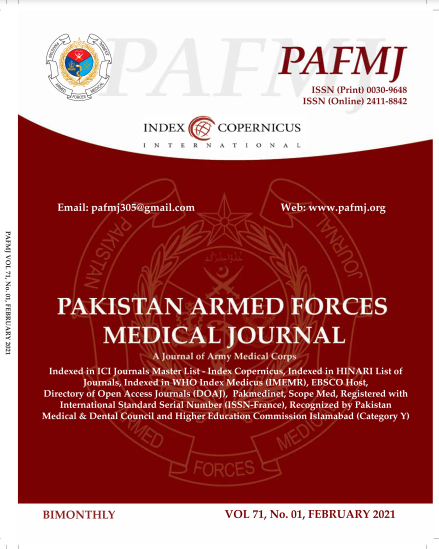D-1 / PD-L1 EXPRESSION IN INVASIVE BREAST CARCINOMA / CANCER
DOI:
https://doi.org/10.51253/pafmj.v71i1.3128Keywords:
Invasive breast cancer, Programmed cell death protein 1, Programmed death-ligand 1Abstract
Objective: To investigate the immunohistochemical expression of PD-1 and PD-L1 in breast cancer cases and its
correlation with clinicopathological factors.
Study Design: Cross sectional study.
Place and Duration of Study: Histopathology department, Armed Forces Institute of Pathology Rawalpindi, form Jan to Jun 2019.
Methodology: Sixty five cases of breast cancer were retrieved. Clinicopathological parameters like age, gender,
tumor grade and receptor status were noted. Immunohistochemistry for PD-1 and PD-L1 was applied. The data
was entered and statistical analysis was done using SPSS version 21. The associations between variables were
found using the Fisher exact test.
Results: Sixty five cases of breast cancer were investigated from tumour registry. The sample included female
patients, having mean age of 50.86 ± 11.1 Years. Invasive mammary (ductal) carcinoma, NST was the most prevalent subtype 60 (92.3%) and most tumors were grade I/II 53(82%). PD-1 expression was seen in TIL’s 31 (48%) and PD-L1 expression was observed in tumour cells 30 (46%). Expression of PD-1/PD-L1 expression was more common in premenopausal age group and grade I/II tumors. Among molecular subtypes, PD-L1 expression was detected in 11 (52%) TNBC, 5 (71%) in HR-/HER2+ and 12 (32)% in HR + HER2 - and PD-1 expression was observed in 13 (62%) TNBC, 5 (71%) in HR-/HER2+ and 13 (35%) in HR+ HER2-.
Conclusion: A large proportion of breast cancer cases show expression of PD-1 / PD-L1. Anti PD-1 and PD-L1
therapy may benefit these patients.





